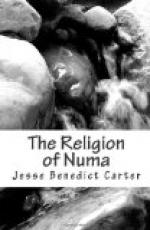Castor was thus the patron of the “horsemen” (equites) and his great day was July 15, when the horsemen’s parade took place. Possibly this had been the date of the festival at Tusculum, a day especially appropriate because it was the Ides of the month, and the Ides were sacred to Juppiter, whose sons Castor and Pollux (Dios-kouroi) were supposed to be. It is extremely interesting in the light of this knowledge of the true state of affairs to see how legend later explained the coming of Castor and Pollux. It was an incident in the mythical war which was supposed to have taken place after the last Tarquin had been driven out, and the republic had been started. The adversaries of Rome, allied with Tarquin, notably Octavius Mamilius of Tusculum, fought against the Romans in the battle of Lake Regillus on July 15, B.C. 499. The Romans won, and the first news of victory was brought to Rome by the miraculous appearance of Castor and Pollux who were seen watering their horses in the Forum at the spring of Juturna. A temple on this spot was then vowed and fifteen years later, B.C. 484, it was completed and dedicated. Tusculum, July 15, and the dedication of the temple in B.C. 484 are seemingly the only historical facts in this legend; and long before B.C. 499 Castor was worshipped in Rome, especially on July 15. The site of his original worship was without doubt the same locality in the Forum where his temple was subsequently built, for it is an almost invariable rule that the earliest temples are built on the actual site of, or close to, the old altar or shrine which preceded the formal temple. Like Hercules therefore he was received inside the pomerium, and probably for a similar reason, because it was felt that he was a god of Tusculum, and hence a god of Rome’s




